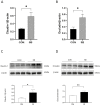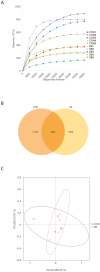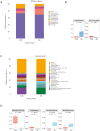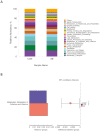Sodium butyrate administration improves intestinal development of suckling lambs
- PMID: 38285605
- PMCID: PMC10889743
- DOI: 10.1093/jas/skae028
Sodium butyrate administration improves intestinal development of suckling lambs
Abstract
This study was conducted to investigate the effects of sodium butyrate (SB) supplementation on growth performance, intestinal barrier functions, and intestinal bacterial communities in sucking lambs. Forty lambs of 7 d old, with an average body weight (BW) of 4.46 ± 0.45 kg, were allocated into the control (CON) or SB group, with each group having five replicate pens (n = 5). Lambs were orally administered SB at 1.8 mL/kg BW in the SB group or the same volume of saline in the CON group. Treatments were administered from 7 to 35 d of age, when one lamb from each replicate was slaughtered to obtain intestinal tissues and contents. The results showed that supplementation with SB tended to increase the BW (P = 0.079) and the starter intake (P = 0.089) of lambs at 35 d of age. The average daily gain of lambs in the SB group was significantly greater than that in the CON group (P < 0.05). The villus height of jejunum in the SB group was markedly higher (P < 0.05) than that in the CON group. In ileum, lambs in the SB group had lower (P < 0.05) crypt depth and greater (P < 0.05) villus-to-crypt ratio than those in the CON group. Compared with the CON group, the mRNA and protein expressions of Claudin-1 and Occludin were increased (P < 0.05) in the SB group. Supplementation with SB decreased the relative abundances of pathogenic bacteria, including Clostridia_UCG-014 (P = 0.094) and Romboutsia (P < 0.05), which were negatively associated with the intestinal barrier function genes (P < 0.05). The relative abundance of Succiniclasticum (P < 0.05) was higher in the SB group, and it was positively correlated with the ratio of villi height to crypt depth in the jejunum (P < 0.05). Compared with the CON group, the function "Metabolism of Cofactors and Vitamins" was increased in the SB group lambs (P < 0.05). In conclusion, SB orally administration during suckling period could improve the small intestine development and growth performance of lambs by inhibiting the harmful bacteria (Clostridia_UCG-014, Romboutsia) colonization, and enhancing intestinal barrier functions.
Keywords: intestinal barrier; intestinal microbiota; sodium butyrate; suckling lambs.
Plain language summary
It is well known that butyrate and its derivatives have various benefits for the rumen development of ruminants, whereas its effects on the small intestine in preweaned lambs have received little attention. Therefore, the present study investigated the effects of sodium butyrate (SB) supplementation on growth performance, intestinal barrier functions, and intestinal bacterial communities in sucking lambs. The results indicated that SB dietary treatment has beneficial effects on the small intestine development and growth performance of suckling lambs.
© The Author(s) 2024. Published by Oxford University Press on behalf of the American Society of Animal Science. All rights reserved. For permissions, please e-mail: journals.permissions@oup.com.
Conflict of interest statement
The authors declare no conflicts of interest in this work, and editors and editorial board members of the journal are neither included in the list of authors nor contributors.
Figures










Similar articles
-
Butyrate Supplementation Improves Intestinal Health and Growth Performance in Livestock: A Review.Biomolecules. 2025 Jan 8;15(1):85. doi: 10.3390/biom15010085. Biomolecules. 2025. PMID: 39858479 Free PMC article. Review.
-
Infusion of sodium butyrate promotes rumen papillae growth and enhances expression of genes related to rumen epithelial VFA uptake and metabolism in neonatal twin lambs.J Anim Sci. 2019 Feb 1;97(2):909-921. doi: 10.1093/jas/sky459. J Anim Sci. 2019. PMID: 30535158 Free PMC article.
-
Effect of feeding calcium gluconate embedded in a hydrogenated fat matrix on feed intake, gastrointestinal fermentation and morphology, intestinal brush border enzyme activity and blood metabolites in growing lambs.J Anim Sci. 2022 Aug 1;100(8):skac205. doi: 10.1093/jas/skac205. J Anim Sci. 2022. PMID: 35652468 Free PMC article.
-
Effect of method of delivery of sodium butyrate on maturation of the small intestine in newborn calves.J Dairy Sci. 2014 Feb;97(2):1026-35. doi: 10.3168/jds.2013-7251. Epub 2013 Dec 15. J Dairy Sci. 2014. PMID: 24342681 Clinical Trial.
-
Sodium butyrate alleviates high ambient temperature-induced oxidative stress, intestinal structural disruption, and barrier integrity for growth and production in growing layer chickens.BMC Vet Res. 2025 Mar 3;21(1):131. doi: 10.1186/s12917-025-04583-5. BMC Vet Res. 2025. PMID: 40025581 Free PMC article.
Cited by
-
The Effect of Microbiome-Derived Metabolites in Inflammation-Related Cancer Prevention and Treatment.Biomolecules. 2025 May 8;15(5):688. doi: 10.3390/biom15050688. Biomolecules. 2025. PMID: 40427581 Free PMC article. Review.
-
The expression pattern of butyric acid transporter in the large intestine with growth and development of suckling lambs.Anim Biosci. 2025 May;38(5):968-980. doi: 10.5713/ab.24.0490. Epub 2025 Jan 24. Anim Biosci. 2025. PMID: 39901713 Free PMC article.
-
Butyrate Supplementation Improves Intestinal Health and Growth Performance in Livestock: A Review.Biomolecules. 2025 Jan 8;15(1):85. doi: 10.3390/biom15010085. Biomolecules. 2025. PMID: 39858479 Free PMC article. Review.
-
Supplementation of coated sodium butyrate relieved weaning stress and reshaped microbial flora in weaned lambs.Front Vet Sci. 2024 Jul 22;11:1423920. doi: 10.3389/fvets.2024.1423920. eCollection 2024. Front Vet Sci. 2024. PMID: 39104550 Free PMC article.
-
Effects of Postpartal Relative Body Weight Change on Production Performance, Serum Biomarkers, and Fecal Microbiota in Multiparous Holstein Cows.Animals (Basel). 2025 Apr 29;15(9):1252. doi: 10.3390/ani15091252. Animals (Basel). 2025. PMID: 40362065 Free PMC article.
References
-
- Amin, A. B., Trabi E. B., Zhu C., and Mao S... 2022. Role of butyrate as part of milk replacer and starter diet on intestinal development in pre-weaned calves. A systematic review. Anim. Feed Sci. Technol. 292:115423. doi: 10.1016/j.anifeedsci.2022.115423 - DOI
-
- Bertiaux-Vandaele, N., Youmba S. B., Belmonte L., Lecleire S., Antonietti M., Gourcerol G., Leroi A. M., Dechelotte P., Menard J. F., Ducrotte P.,. et al.. 2011. The expression and the cellular distribution of the tight junction proteins are altered in irritable bowel syndrome patients with differences according to the disease subtype. Am. J. Gastroenterol. 106:2165–2173. doi: 10.1038/ajg.2011.257 - DOI - PubMed
MeSH terms
Substances
LinkOut - more resources
Full Text Sources

